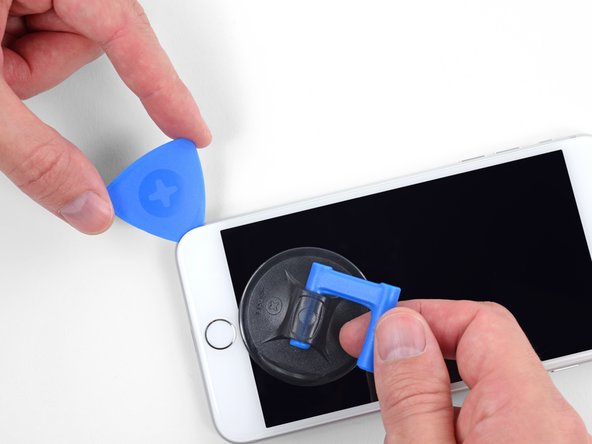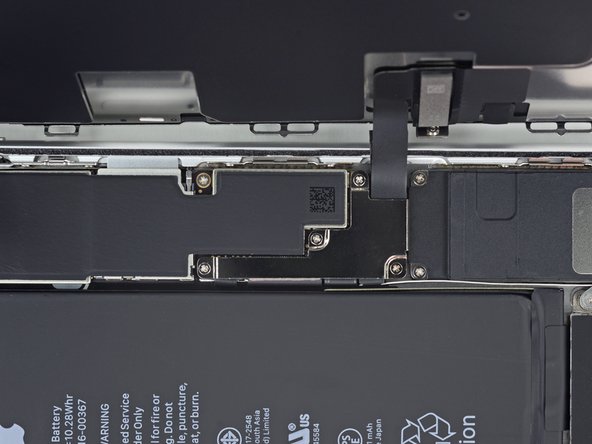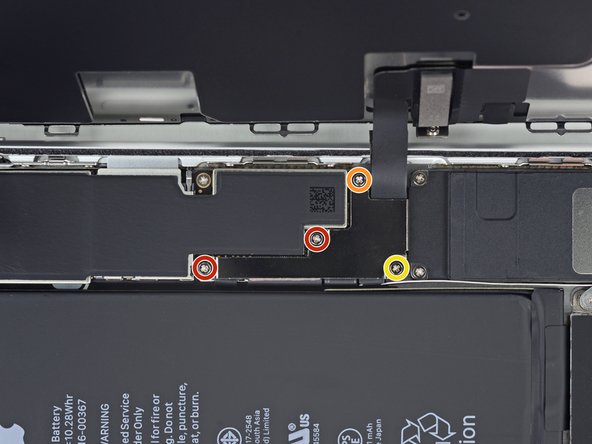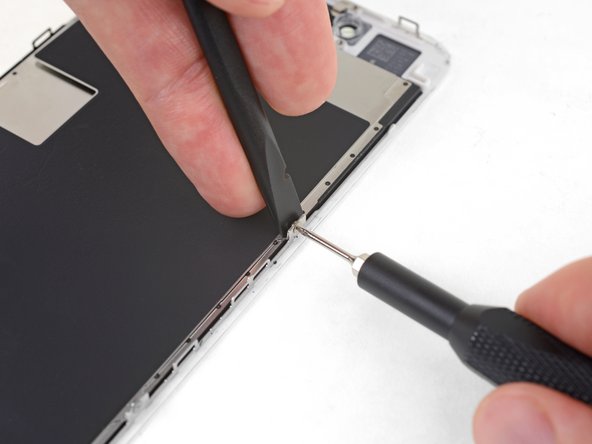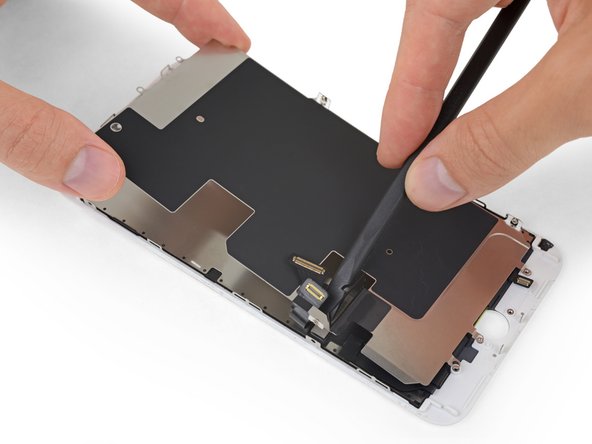iPhone 8 Plus LCD and Digitizer Replacement
Duration: 45 minutes
Steps: 51 Steps
Give your device a high-five by moving the original home/Touch ID sensor over to the new display—it's the secret to keeping everything working smoothly.
Looking for a quick fix? Grab our repair kit and follow this streamlined guide to swap out your iPhone's whole screen. But if you're up for a bit more of a challenge, this guide walks you through replacing just the iPhone 8 Plus LCD and digitizer (yep, the front panel). You’ll need to transfer a few pieces from your original screen to the new one—like the front-facing camera, earpiece speaker, LCD shield plate, and home button assembly. Just a heads up: for any screen swap, make sure you carefully move over the original home/Touch ID sensor to the new display to keep it working properly. The home button's a bit picky since it’s paired with the logic board, so replacing it means it won’t work anymore. Also, if the auto-brightness is acting up after your screen swap, check that your iPhone’s running iOS 12. And note: after replacing the screen, True Tone is switched off, even if you're using an original Apple display. If you find yourself stuck, don’t worry—you can always schedule a repair.
Step 1
Before you dive in, make sure your iPhone's battery is below 25%. A fully charged lithium-ion battery can be a bit dramatic and could catch fire or even explode if it gets punctured. Safety first, my friend!
Opening up your iPhone’s display might let the water gods in, compromising those precious waterproof seals. So, make sure to have some replacement seals on hand before diving into this step. If you choose to reassemble your iPhone without new seals, be extra careful to keep it away from any liquid adventures!
- First things first, let's make sure your iPhone is taking a little nap before we dive in for some disassembly fun!
- Now, grab your trusty screwdriver and carefully remove those two 3.5 mm pentalobe screws from the bottom edge of your iPhone. You've got this!
Step 2
Pushing your pick in too deep can cause some unwanted damage—let’s avoid that! Mark your pick to know exactly how far to go.
Feel free to mark the other corners with different measurements for extra precision.
Another cool trick: tape a coin to your pick about 3 mm from the tip to keep your depth on point.
- Measure 3 mm from the tip and mark your opening pick with a permanent marker to keep things precise and tidy.
Step 3
Safety first! Pop on those safety glasses to keep your eyes safe from any rogue glass bits that might jump out during the repair.
Tape keeps those sneaky glass shards in check and gives your screen some backup muscle when you're popping it off.
- If your display glass is cracked, keep the shards in check and avoid any ouch moments by taping over the glass before starting your repair.
- Stick overlapping strips of clear packing tape across the iPhone's screen until it’s fully covered.
- If the cracked glass makes it tricky for a suction cup to grab hold in the next steps, fold a strong tape like duct tape into a little handle and use that to lift the display instead.
Step 4
Pop on some safety glasses to keep your eyes safe from any sneaky glass shards that might decide to make a break for it during the repair.
Got a cracked iPhone screen? No worries! Just tape over the glass to stop it from shattering further and keep things safe while you work on it.
If you're stuck, try supergluing the suction cup to the screen for a little extra grip. It could do the trick!
- Lay down some clear packing tape over the iPhone’s screen, overlapping each strip until the whole front is covered. It's like giving it a cozy, protective blanket.
- If the suction cup just isn’t sticking when you need it, no worries! Grab some strong tape (like duct tape) and fold it into a handle. Use that to gently lift the screen instead.
Step 5
Next up: three steps with the Anti-Clamp, our trusty sidekick for easier opening. If you don’t have the Anti-Clamp, just jump ahead three steps for the alternate route.
Want the full scoop on using the Anti-Clamp? Check out the guide linked here.
Slippery iPhone? No worries—stick on some tape to give the Anti-Clamp a better grip.
- Grab the blue handle and pull it back to free the Anti-Clamp’s arms.
- Slide those arms over the left or right side of your iPhone.
- Place the suction cups near the bottom edge of your iPhone, just above the home button—one on the front and one on the back.
- Give the cups a good squeeze to get a solid grip on the area.
Step 6
- Slide the blue handle forward to lock those arms in place.
- Give the handle a smooth 360-degree turn clockwise, or keep going until the suction cups start to stretch a bit.
- Keep an eye on the suction cups — they should stay perfectly lined up. If they start to drift, loosen them a touch and realign the arms before moving on.
Step 7
Take it easy, champ! Just a gentle turn—no more than a quarter of a twist at a time. After each turn, chill for a minute and let the Anti-Clamp and time do their magic. You've got this!
Feeling a little heated? You can always grab a hair dryer, heat gun, or hot plate to warm things up—but watch out! Too much heat can mess with your display or internal battery. So, keep it cool and proceed with caution.
If the Anti-Clamp isn't making enough room, no worries! Just add some extra heat to the area and give that handle a little twist—about a quarter turn should do the trick!
- Warm up an iOpener and guide it carefully through the arms of the Anti-Clamp.
- Fold the iOpener so it rests snugly along the bottom edge of the iPhone.
- Give it about a minute to let the adhesive soften and create a small gap.
- Once the Anti-Clamp opens a nice gap, slide an opening pick under the screen.
- Skip the next three steps.
Tools Used
Step 8
The next three steps will guide you through popping the screen off using a suction cup.
Warming up the bottom edge of your iPhone helps loosen the glue holding the display in place, making it much easier to pry open.
- Grab a trusty hairdryer or whip up an iOpener, and give the lower edge of your iPhone some warm love for about 90 seconds. This will help melt the adhesive lurking underneath, making it easier for you to get in there and do your magic!
Tools Used
Step 9
Make sure the suction cup steers clear of the home button—otherwise, you’ll have a tough time getting that seal you need between the suction cup and the front glass.
- Grab a suction cup and stick it on the lower part of the front panel, just a smidge above the home button. You're doing great!
Step 10
That waterproof adhesive is seriously holding on for dear life, so cracking open a gap might take some muscle. If it’s being stubborn, hit it with more heat and gently wiggle the screen—it’ll loosen up. Once you see enough space, slide your tool right in.
- Gently tug on that suction cup with steady, confident pressure to open up a little gap between the front panel and the rear case. You're on your way!
- Now, grab an opening pick or a similarly thin pry tool and slide it a few millimeters into that sweet little gap you've created.
Step 11
- Glide your pick around the corner and up the left side of the phone—head towards those volume buttons and the silent switch, and keep breaking up that stubborn adhesive holding the display.
- Pause when you reach the top left corner of the screen.
Step 12
Heads up! There's a fragile cable running along the right edge of your iPhone. Avoid sliding your pick in there or you might accidentally mess it up.
Step 13
Keep your pick shallow—no more than 3 mm—to avoid messing up those delicate display cables.
- Gently slide your tool back into the lower right corner of the iPhone, then carefully glide it around the corner and up the right edge to loosen that stubborn adhesive.
Step 14
Keep the display tilt under 15º to avoid stressing or snapping those delicate ribbon cables hanging out inside.
- Carefully lift the bottom edge of the display by pulling up on the suction cup with a gentle touch.
Step 15
- Give that little nub on the suction cup a gentle tug to pop it off the front panel. You've got this!
Step 16
- Carefully slide an opening pick under the top edge of the display to gently break through the last bit of stubborn adhesive.
Step 17
- Gently slide the display assembly down a bit, away from the phone's top edge, to pop those clips loose from the rear case. You've got this!
Step 18
Hold off on pulling the display all the way off just yet—there are still some delicate ribbon cables hanging out, keeping it connected to your iPhone’s logic board.
- Start by opening the iPhone like a book—flip the display up from the left side.
- Prop the display up by leaning it against something stable so it stays out of the way while you work.
Step 19
- Let's kick things off by removing those four Phillips (JIS) screws that hold the lower display cable bracket snugly against the logic board. Here's what you need to look for in terms of screw lengths:
- And hey, while you're at it, keep a close eye on your screws! It's super important to make sure each one finds its way back to its original home during reassembly. Mixing them up can lead to some serious issues down the line.
- Two little 1.3 mm screws
- One sneaky 1.4 mm screw
- One hefty 2.7 mm screw
Step 20
- Time to take off that lower display cable bracket! A little twist, a little pull, and it should come right off. Don't worry, it's not as tough as it sounds. Keep it steady and you'll be all set!
Step 21
- Gently use the pointy end of a spudger to lift the battery connector away from its spot on the logic board.
- Give the connector cable a little bend upwards so it doesn’t accidentally touch the socket and power up the phone while you’re working.
Tools Used
Step 22
- Grab a spudger or your trusty fingernail to gently pop that big lower display connector right out of its cozy socket. Just pry it straight up, and you'll be on your way!
- When it's time to snap the connectors back in, just press down on one side until you hear that satisfying click, and then do the same on the other side. Avoid pressing in the middle! If it feels even a tad off, it could bend and cause some serious trouble. So let's keep it aligned and happy!
Tools Used
Step 23
- Time to unplug the second lower display cable connector, which is right behind the one you just disconnected. You've got this!
Step 24
- Take out the two tri-point Y000 screws holding down the bracket that covers the front panel sensor assembly connector:
- One 1.0 mm screw
- One 1.2 mm screw
Step 25
- Gently lift off the bracket that’s guarding the front panel sensor connector.
Step 26
- Gently pry open the front panel sensor assembly connector from its socket using the tip of a spudger or your trusty fingernail. You've got this!
Tools Used
Step 27
- Lift out the display assembly and set it aside like you’re handling a slice of fancy cake.
- If you’re feeling extra, this is a great spot to refresh the adhesive around the edges before you put things back together.
Step 28
- Alright, let's get those screws out! You’ll want to remove the five Phillips screws holding the earpiece speaker bracket in place. Here’s what you need to unscrew:
- Two 1.8 mm screws – they’re the tiny ones, don’t let them sneak away!
- One 2.3 mm screw – a little bigger, but still no match for you!
- One 2.4 mm screw – getting just a bit more noticeable now.
- One 2.8 mm screw – this one is the largest, but you’ve got this!
Step 29
- Gently lift off the earpiece speaker bracket. Take your time, and remember to keep it steady—no rush here!
Step 30
- Take your trusty spudger and carefully lift the front-facing camera out of its cozy spot.
- Give the camera ribbon a gentle nudge to the side so you can get a clear path to the earpiece speaker hiding underneath.
Tools Used
Step 31
- Gently pop out that earpiece speaker to get it out of the way.
Step 32
- Carefully fold the camera and its ribbon cable down toward the bottom of the iPhone to give yourself some room to work on the parts underneath.
Step 33
The sensors in the upcoming steps are a bit delicate, so let's treat them with care! To boost your chances of lifting them off safely, feel free to apply some extra heat as needed. You can also drop a bit of isopropyl alcohol around them and let it seep in before you gently pry them up. You've got this!
- Grab a hairdryer, heat gun, or an iOpener, and gently warm up the top front of the display for about a minute. This will help soften the adhesive holding the sensors in place, making the next steps a breeze!
Tools Used
Step 34
- Gently slide a spudger underneath the ambient light sensor flex cable, then carefully lift the sensor out of its cozy little spot.
Tools Used
Step 35
- Gently slide the spudger's tip beneath the proximity sensor flex cable and carefully lift the sensor out from its snug little home.
Tools Used
Step 36
Grab your trusty iOpener or a hair dryer to warm up the top part of the display. This will help loosen up the adhesive holding that flex cable in place. You're doing great!
- Slide the pointed end of your opening tool under the camera assembly's flex cable, opposite the front-facing camera.
- Gently lift to separate the flex cable's edge from the back of the display.
Tools Used
Step 37
- Slide the point of your trusty spudger right under the part of the flex cable you just worked on. We’re getting there!
- Keep on going! Carefully separate the rest of that flex cable by pushing the spudger beneath the row of those shiny circular gold earpiece speaker contacts.
Tools Used
Step 38
- Lift out the front camera and sensor cable assembly—nice and easy.
- You’ll spot a strip of black double-sided insulating tape hanging out between the display and those shiny copper contacts on the back of the cable. Sometimes it sticks to the display, sometimes it tags along with the cable. No drama.
- Putting things back together? Make sure that tape is chilling in its usual spot. If it’s gone missing, just cover those copper contacts with something like Kapton tape—your cable will thank you.
Step 39
- Take out the four Y000 screws holding down the bracket over the home/Touch ID sensor:
- When putting things back together, go easy on these screws—cranking them down too hard can make your home button act up.
- One screw is 1.2 mm long
- Three screws are 1.3 mm long
Step 40
- Pop off the bracket that holds the home/Touch ID sensor in place.
Step 41
If the whole connector starts to pop up without really letting go, give the top edge of the connector a gentle press down with your spudger while you carefully pry up the left edge. Just a friendly reminder—be super cautious not to mess up the cable or connector, or you might end up putting the sensor out of commission for good!
- Gently slide your tool under the left side of the home button cable connector and pop it free from its socket.
Tools Used
Step 42
Keep the display warm, but not like you’re trying to cook an egg on it! A gentle warmth should be enough to get the job done.
Warm up the area around the home/Touch ID sensor to gently loosen up that adhesive holding the fragile cable. This will make it much easier to safely lift and remove it without any trouble.
- Flip the display assembly over. Grab a hairdryer or your trusty iOpener and give the lower edge of the display some heat for about 90 seconds. This will soften up that stubborn adhesive hiding underneath, making it easier to work with.
Tools Used
Step 43
- Grab an opening pick and carefully slide it in to loosen the adhesive holding the home/Touch ID sensor cable on the back of the display panel—easy does it!
Step 44
- Gently lift out the home/Touch ID sensor assembly from the front of the display. It’s like threading a needle, but with tech!
- When putting it all back together, thread the cable through the display’s front hole. You got this!
- If your replacement part comes with some extra Y000 screws hanging around the Home Button, go ahead and remove those to make room for the home button bracket. No clutter here!
Step 45
No need to peel off the sticker completely unless you're planning on swapping it out.
- Gently lift the top part of the LCD shield plate sticker, peeling it back to free it from the flex cable below. Take it slow, and it’ll come off like a charm!
Step 46
If those screws are being stubborn, try pressing your driver down a bit more firmly as you turn. To get extra grip without bending the display clips, wedge the flat edge of your spudger behind each clip for some solid support while you loosen the screws.
- Grab your Y000 driver and unscrew the three 1.2 mm screws hanging out on one side of the display EMI shield. Easy does it!
Tools Used
Step 47
- Grab your trusty Y000 driver and let's tackle those two 1.2 mm screws on the opposite side of the EMI shield. You've got this!
Step 48
- Take out the 1.8 mm Phillips screw holding down the EMI shield at the bottom of the display. Easy does it!
Step 49
- Gently lift the LCD shield plate while keeping a thumb on the flex cable to keep it in place.
- Carefully thread the flex cable through the opening in the LCD shield plate, making sure it doesn’t catch on anything.
Step 50
- Gently pop off the LCD shield plate to get things rolling.
Step 51
- Take a moment to compare your shiny new replacement part with the old one—don't forget to transfer any leftover components or peel off those pesky adhesive backings before you dive into installation!
- Time to put your device back together! Just retrace your steps from earlier, and you'll be back in business in no time.
- Got some e-waste? Make sure to drop it off at an R2 or e-Stewards certified recycler—it's good for the planet!
- If things didn’t go as smoothly as you hoped, no worries! Swing by our Answers community for some troubleshooting tips and support. And if you’re feeling stuck, remember you can always schedule a repair.




























